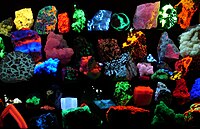
Photo from wikipedia
Stable solid-state red fluorescence from organosilane-functionalized carbon dots (CDs) with sizes around 3 nm is reported for the first time. Meanwhile, a novel method is also first reported for the… Click to show full abstract
Stable solid-state red fluorescence from organosilane-functionalized carbon dots (CDs) with sizes around 3 nm is reported for the first time. Meanwhile, a novel method is also first reported for the efficient construction of dual-fluorescence morphologies. The quantum yield of these solid-state CDs and their aqueous solution is 9.60 and 50.7%, respectively. The fluorescence lifetime is 4.82 ns for solid-state CDs, and 15.57 ns for their aqueous solution. These CDs are detailedly studied how they can exhibit obvious photoluminescence overcoming the self-quenching in solid state. Luminescent materials are constructed with dual fluorescence based on as-prepared single emissive CDs (red emission) and nonfluorescence media (starch, Al2 O3 , and RnOCH3 COONa), with the characteristic peaks located at nearly 440 and 600 nm. Tunable photoluminescence can be successfully achieved by tuning the mass ratio of CDs to solid matrix (such as starch). These constructed dual-fluorescence CDs/starch composites can also be applied in white light-emitting diodes with UV chips (395 nm), and oxygen sensing.
Journal Title: Small
Year Published: 2017
Link to full text (if available)
Share on Social Media: Sign Up to like & get
recommendations!